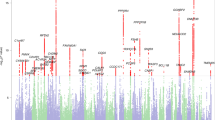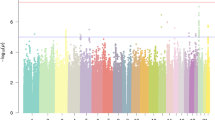Abstract
Dyslexia has been linked to a number of chromosomal regions including 15q. Recently a gene, EKN1, with unknown function in the linked region, was identified via a translocation breakpoint. This gene was further supported as a susceptibility locus by association studies in a Finnish sample. We investigated the possibility of this locus as a susceptibility gene contributing to dyslexia, analyzed as a categorical trait, and analyzed key reading phenotypes as quantitative traits using six polymorphisms including the two previously reported to be associated with dyslexia. In our sample of 148 families identified through a proband with reading difficulties, we found significant evidence for an association to dyslexia analyzed as a categorical trait and found evidence of association to the reading and related processes of phonological awareness, word identification, decoding, rapid automatized naming, language ability, and verbal short-term memory. However, association was observed with different alleles and haplotypes than those reported to be associated in a Finnish sample. These findings provide support for EKN1 as a risk locus for dyslexia and as contributing to reading component processes and reading-related abilities. Based on these findings, further studies of this gene in independent samples are now required to determine the relationship of this gene to dyslexia.
This is a preview of subscription content, access via your institution
Access options
Subscribe to this journal
Receive 12 print issues and online access
$259.00 per year
only $21.58 per issue
Buy this article
- Purchase on Springer Link
- Instant access to full article PDF
Prices may be subject to local taxes which are calculated during checkout

Similar content being viewed by others
References
Pennington BF . Using genetics to dissect cognition (editorial; comment). Am J Hum Genet 1997; 60: 13–16.
Olson R, Forsberg H, Wise B, Rack J . Measurement of word recognition, orthographic, and phonological skills. In: Lyon GR (ed). Frames of Reference for the Assessment of Learning Disabilities. Paul H Brookes: Baltimore, 1994 pp 243–277.
Wadsworth SJ, DeFries JC, Fulker DW, Olson RK, Pennington BF . Reading performance and verbal short-term memory: a twin study of reciprocal causation. Intelligence 1995; 20: 145–167.
Davis CJ, Gayan J, Knopik VS, Smith SD, Cardon LR, Pennington BF et al. Etiology of reading difficulties and rapid naming: the Colorado Twin Study of Reading Disability. Behav Genet 2001; 31: 625–635.
Lefly DL, Pennington BF . Reliability and validity of the adult reading history questionnaire. J Reading Disabil 2000; 33: 286–296.
Bruck M . Persistence of dyslexics' phonological awareness deficits. Dev Psychol 1992; 28: 874–886.
Bishop DV, Adams C . A prospective study of the relationship between specific language impairment, phonological disorders and reading retardation. J Child Psychol Psychiatry 1990; 31: 1027–1050.
Gathercole SE, Baddeley AD . The processes underlying segmental analysis. Eur Bull Cogn Psychol 1987; 7: 462–464.
Scarborough HS . Very early language deficits in dyslexic children. Child Dev 1990; 61: 1728–1743.
Scarborough HS . Early identification of children at risk for reading disabilities. In: Shaprio BK, Accardo PJ, Capute AJ (eds). Specific Reading Disability: A View of the Spectrum. York Press: Timonium, MD, 1998 pp 75–119.
Snowling M, Bishop DV, Stothard SE . Is preschool language impairment a risk factor for dyslexia in adolescence? J Child Psychol Psychiatry 2000; 41: 587–600.
Hohnen B, Stevenson J . The structure of genetic influences on general cognitive, language, phonological, and reading abilities. Dev Psychol 1999; 35: 590–603.
Wolf M, Bowers PG . The double-deficit hypothesis for the developmental dyslexias. J Educ Psychol 1999; 91: 415–438.
Wolf M, Goldberg A, Gidney C, Lovett MW, Cirino P, Morris RD . The second deficit: an investigation of the independence of phonological and naming-speed deficits in developmental dyslexia. Reading Writing Interdiscipl J 2002; 15: 43–72.
Lovett MW, Steinbach KA, Frijters JC . Remediating the core deficits of developmental reading disability: a double deficit perspective. J Learn Disabil 2000; 33: 334–358.
Jorm AF . The cognitive and neurological basis of developmental dyslexia: a theoretical framework and review. Cognition 1979; 7: 19–33.
Rugel RP . WISC subtest scores of disabled readers: a review with respect to Bannatyne's recategorization. J Learn Disabil 1974; 7: 57–64.
Stanovich KE . Individual differences in the cognitive processes of reading: II. Text-level processes. J Learn Disabil 1982; 15: 549–554.
Rabin M, Wen XL, Hepburn M, Lubs HA, Feldman E, Duara R . Suggestive linkage of developmental dyslexia to chromosome 1p34–p36. Lancet 1993; 342: 178.
Grigorenko EL, Wood FB, Meyer MS, Pauls JE, Hart LA, Pauls DL . Linkage studies suggest a possible locus for developmental dyslexia on chromosome 1p. Am J Med Genet 2001; 105: 120–129.
Smith SD, Kimberling WJ, Pennington BF, Lubs HA . Specific reading disability: identification of an inherited form through linkage analysis. Science 1983; 219: 1345–1347.
Grigorenko EL, Wood FB, Meyer MS, Hart LA, Speed WC, Shuster A et al. Susceptibility loci for distinct components of developmental dyslexia on chromosomes 6 and 15. Am J Hum Genet 1997; 60: 27–39.
Morris DW, Robinson L, Turic D, Duke M, Webb V, Milham C et al. Family-based association mapping provides evidence for a gene for reading disability on chromosome 15q. Hum Mol Genet 2000; 9: 843–848.
Smith SD, Kimberling WJ . Reading disabilities. In: Pennington B (ed). Genetic and Neurological Influences. Kluwer Academic: Boston, 1991.
Cardon LR, Smith SD, Fulker DW, Kimberling WJ, Pennington BF, DeFries JC . Quantitative trait locus for reading disability on chromosome 6. Science 1994; 266: 276–279.
Turic D, Robinson L, Duke M, Morris DW, Webb V, Hamshere M et al. Linkage disequilibrium mapping provides further evidence of a gene for reading disability on chromosome 6p21.3–22. Mol Psychiatry 2003; 8: 176–185.
Fisher SE, Marlow AJ, Lamb J, Maestrini E, Williams DF, Richardson AJ et al. A quantitative-trait locus on chromosome 6p influences different aspects of developmental dyslexia. Am J Hum Genet 1999; 64: 146–156.
Grigorenko EL, Wood FB, Meyer MS, Pauls DL . Chromosome 6p influences on different dyslexia-related cognitive processes: further confirmation. Am J Hum Genet 2000; 66: 715–723.
Fagerheim T, Raeymaekers P, Tonnessen FE, Pedersen M, Tranebjaerg L, Lubs HA . A new gene (DYX3) for dyslexia is located on chromosome 2. J Med Genet 1999; 36: 664–669.
Petryshen TL, Kaplan BJ, Hughes ML, Tzenova J, Field LL . Supportive evidence for the DYX3 dyslexia susceptibility gene in Canadian families. J Med Genet 2002; 39: 125–126.
Fisher SE, Francks C, Marlow AJ, MacPhie IL, Newbury DF, Cardon LR et al. Independent genome-wide scans identify a chromosome 18 quantitative-trait locus influencing dyslexia. Nat Genet 2002; 30: 86–91.
Petryshen TL, Kaplan BJ, Liu MF, Schmill de French N, Tobias R, Hughes ML et al. Evidence for a susceptibility locus on chromosome 6q influencing phonological coding dyslexia. Am J Med Genet (Neuropsychiatr Genet) 2001; 105: 507–517.
Nopola-Hemmi J, Myllyluoma B, Haltia T, Taipale M, Ollikainen V, Ahonen T et al. A dominant gene for developmental dyslexia on chromosome 3. J Med Genet 2001; 38: 658–664.
Schulte-Korne G, Grimm T, Nothen MM, Muller-Myhsok B, Cichon S, Vogt IR et al. Evidence for linkage of spelling disability to chromosome 15. Am J Hum Genet 1998; 63: 279–282.
Bisgaard ML, Eiberg H, Moller N, Niebuhr E, Mohr J . Dyslexia and chromosome 15 heteromorphism: negative lod score in a Danish material. Clin Genet 1987; 32: 118–119.
Nopola-Hemmi J, Taipale M, Haltia T, Lehesjoki AE, Voutilainen A, Kere J . Two translocations of chromosome 15q associated with dyslexia. J Med Genet 2000; 37: 771–775.
Taipale M, Kaminen N, Nopola-Hemmi J, Haltia T, Myllyluoma B, Lyytinen H et al. A candidate gene for developmental dyslexia encodes a nuclear tetratricopeptide repeat domain protein dynamically regulated in brain. Proc Natl Acad Sci USA 2003; 100: 11553–11558.
Blatch GL, Lassle M . The tetratricopeptide repeat: a structural motif mediating protein–protein interactions. BioEssays 1999; 21: 932–939.
Weller EB, Weller RA, Fristad MA, Rooney MT, Schecter J . Children's Interview for Psychiatric Syndromes (ChIPS). J Am Acad Child Adolesc Psychiatry 2000; 39: 76–84.
Tannock R, Hum M, Masellis M, Humphries T, Schachar R . Teacher Telephone Interview for Children's Academic Performance, Attention, Behavior and Learning: DSM-IV Version (TTI-IV). The Hospital for Sick Children: Toronto, Canada, 2002 (unpublished document).
Wechsler DI . Examiner's Manual: Wechsler Intelligence Scale for Children-Third Edition. Psychological Corporation: New York, NY, 1991.
Wilkinson GS . Wide Range Achievement Test 3—Revision 3. Jastak Associates: Wilmington, DE, 1993.
Woodcock RW . Woodcock Reading Mastery Tests—Revised. American Guidance Service Inc, 1987.
Wagner R, Torgesen J, Rashotte C . Comprehensive Test of Phonological Processing (CTOPP). Pro-Ed: Austin, TX, 1999.
Semel E, Wing E, Secord W . Clinical Evaluation of Language Fundamentals—3rd edn (CELF-3). The Psychological Corporation: San Antonio, TX, 1995.
Miller SA, Dykes DD, Polesky HF . A simple salting out procedure for extracting DNA from human nucleated cells. Nucleic Acids Res 1988; 16: 1215.
Sham PC, Curtis D . An extended transmission/disequilibrium test (TDT) for multi-allele marker loci. Ann Hum Genet 1995; 59: 323–336.
Clayton D . A generalization of the transmission/disequilibrium test for uncertain-haplotype transmission. Am J Hum Genet 1999; 65: 1170–1177.
Horvath S, Xu X, Laird NM . The family based association test method: strategies for studying general genotype–phenotype associations. Eur J Hum Genet 2001; 9: 301–306.
Laird NM, Horvath S, Xu X . Implementing a unified approach to family-based tests of association. Genet Epidemiol 2000; 19 (Suppl 1): S36–S42.
Storey JD, Tibshirani R . Statistical significance for genomewide studies. Proc Natl Acad Sci USA 2003; 100: 9440–9445, (Epub 2003 July 25).
Devlin B, Risch N . A comparison of linkage disequilibrium measures for fine-scale mapping. Genomics 1995; 29: 311–322.
Acknowledgements
This work was supported by grants from the Canadian Institutes of Health Research number MOP-36358.
Author information
Authors and Affiliations
Corresponding author
Rights and permissions
About this article
Cite this article
Wigg, K., Couto, J., Feng, Y. et al. Support for EKN1 as the susceptibility locus for dyslexia on 15q21. Mol Psychiatry 9, 1111–1121 (2004). https://doi.org/10.1038/sj.mp.4001543
Received:
Revised:
Accepted:
Published:
Issue Date:
DOI: https://doi.org/10.1038/sj.mp.4001543
Keywords
This article is cited by
-
Behavior and Molecular Genetic Approaches to Comorbidity
Current Developmental Disorders Reports (2019)
-
Genome-wide association scan identifies new variants associated with a cognitive predictor of dyslexia
Translational Psychiatry (2019)
-
The Influence of Dyslexia Candidate Genes on Reading Skill in Old Age
Behavior Genetics (2018)
-
Neurogenetics of developmental dyslexia: from genes to behavior through brain neuroimaging and cognitive and sensorial mechanisms
Translational Psychiatry (2017)
-
The Roles of Genes in the Neuronal Migration and Neurite Outgrowth Network in Developmental Dyslexia: Single- and Multiple-Risk Genetic Variants
Molecular Neurobiology (2016)



